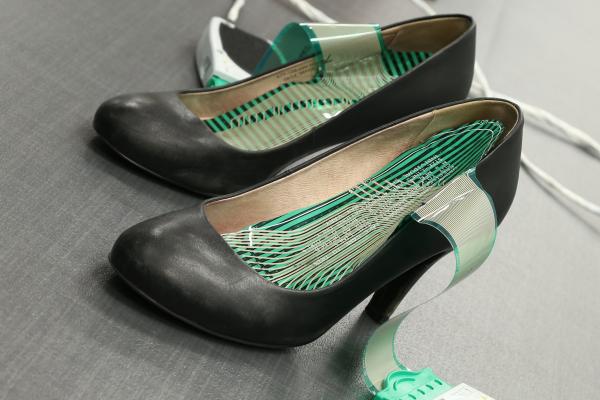SATRA research boosts product development
How the SATRA innovation and development team plays a vital role in helping members turn concept into commercial reality.

Image © The F-Scan in-shoe gait analysis system
SATRA is often approached by members who request assistance to overcome technical challenges in the early stages of their product development process. It is sometimes the case that member companies are unsure of the best tests for their concept designs, and so refer to SATRA for advice. SATRA’s innovation and development team can, if necessary, call upon an incredible base of experience throughout the organisation. This can include guidance from SATRA footwear testing team personnel, who can advise on a wide range of in-depth testing procedures. They can also explain possible modifications to established procedures or assist with the development of new ways of evaluating a product.
At any stage in the development of a product, the innovation and development team may determine that new and more specific protocols, or a series of tests, need to be developed in order to answer a particular challenge.
SATRA can be of valuable assistance in assessing a product which is designed for a niche market with demanding requirements – such as specialist footwear for sub-zero environments, sports shoes or footwear for military and police applications. A shoemaking company often requires sound scientific evidence to support claims it intends to make about a newly developed product. It is best for such evidence to be provided through well-designed tests, and possibly wear trials. Occasionally, this calls for test conditions to be quite aggressive – for instance, by using the SATRA climate chambers which can create conditions ranging from Arctic temperatures of -40ºC through to jungle and desert climates of +50ºC, and between 10 and 90 per cent relative humidity.
Help from stage one
Members may submit their own new designs alongside a range of existing styles in order to determine how their new footwear compares to products already on the market – an action known as ‘benchmarking’. However, it should be remembered that SATRA will not knowingly test a member’s product on behalf of another competing member. If the new item of footwear does not perform as well as expected, we will offer advice on how the required areas can be improved.
Many items of footwear sent in to SATRA by members are submitted for just one particular test. However, it may become apparent that the product should also be subjected to additional testing, so we will discuss this with the member. As an example, a shoe may be submitted for an investigation of moisture absorption, but the SATRA team may realise that constructional issues or fit are equally important, and so need investigation. Making sure that any additional problems are avoided can obviously add value to the product.
Members also have the opportunity to approach SATRA to receive assistance and advice at any stage during the development process. Unfortunately, in our experience, we may be contacted too late to help the footwear producer avoid some manufacturing problems. Difficulties that arise well into a development can be very costly. Therefore, it is worthwhile talking to us at an early stage in the development process, as we can also assess basic aspects of footwear design and production, including manufacturing procedures.
A member may decide to change manufacturing processes of an existing product. Such alterations may include introducing a new material or moving manufacture to another country. Even though the shoe or boot may have been selling well for many years, it is worthwhile asking SATRA to check that the product is still fit for purpose when there has been a change to the production process.
How can we help?
SATRA can be viewed as your research and development partner, and we always strive to make members’ activities successful. Please email innovation@satra.com for further information on our innovation and development services.
Publishing Data
This article was originally published on page 8 of the July/August 2020 issue of SATRA Bulletin.
Other articles from this issue »


 EN
EN ZH
ZH